A Hypothetical Research Design: Leadership and Employee Turnover
VerifiedAdded on 2023/06/05
|8
|1677
|421
Report
AI Summary
This report presents a hypothetical research design to investigate the relationship between organisational leadership and employee turnover in mid-size businesses. The research plan incorporates both qualitative and quantitative methods, acknowledging the different philosophical underpinnings of each approach. The qualitative component aims to explore the 'what' and 'why' behind the research questions, utilizing interviews and existing literature to understand the impact of leadership styles on turnover rates. The quantitative component focuses on numerical data collection through surveys and questionnaires, employing statistical methods to analyse the relationship and test hypotheses related to leadership skills and turnover. Ultimately, the research design seeks to combine the strengths of both qualitative and quantitative approaches to provide a comprehensive and accurate understanding of the complex relationship between leadership styles and employee turnover, with the goal of determining the validity of the proposed hypotheses. Desklib offers a wide array of solved assignments and research resources for students.
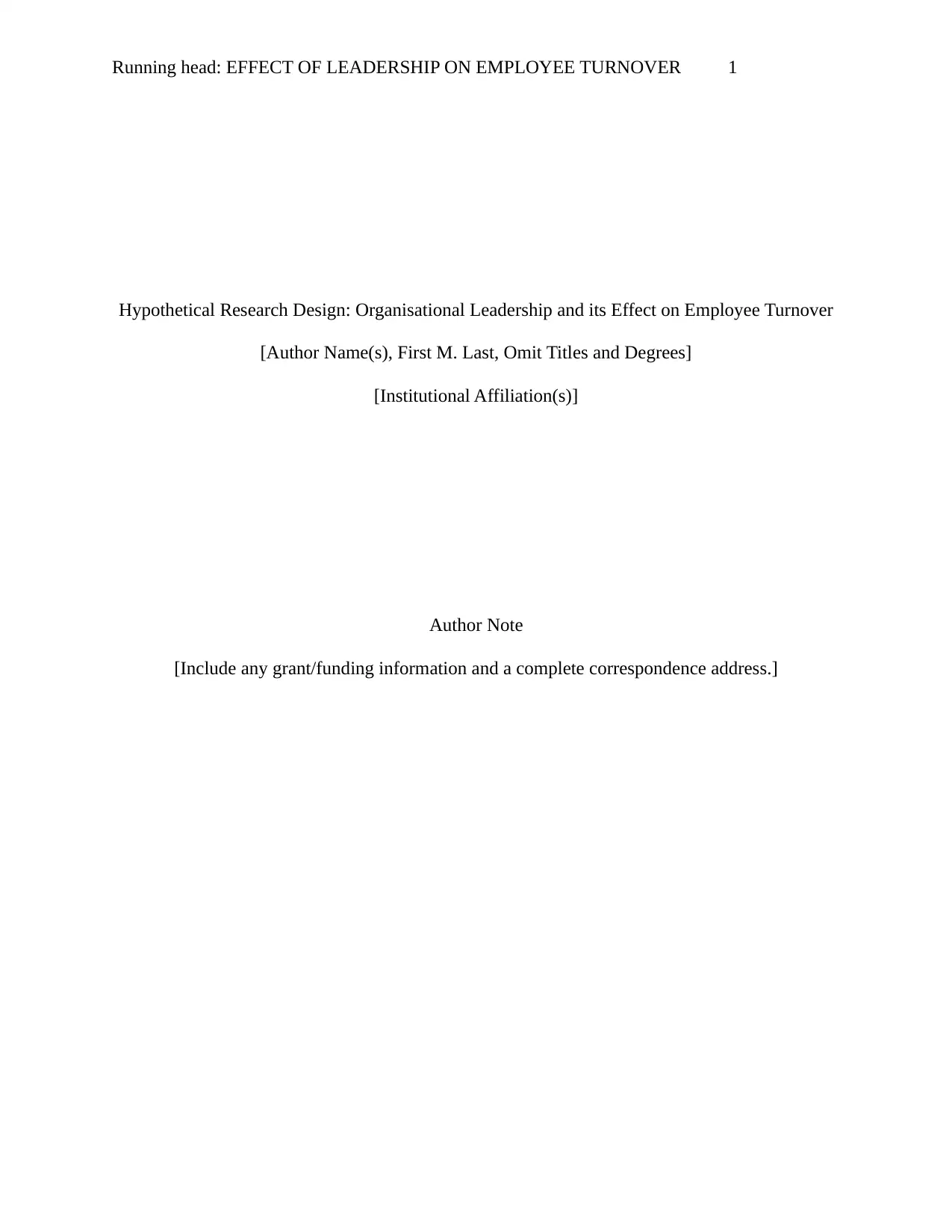
Running head: EFFECT OF LEADERSHIP ON EMPLOYEE TURNOVER 1
Hypothetical Research Design: Organisational Leadership and its Effect on Employee Turnover
[Author Name(s), First M. Last, Omit Titles and Degrees]
[Institutional Affiliation(s)]
Author Note
[Include any grant/funding information and a complete correspondence address.]
Hypothetical Research Design: Organisational Leadership and its Effect on Employee Turnover
[Author Name(s), First M. Last, Omit Titles and Degrees]
[Institutional Affiliation(s)]
Author Note
[Include any grant/funding information and a complete correspondence address.]
Paraphrase This Document
Need a fresh take? Get an instant paraphrase of this document with our AI Paraphraser
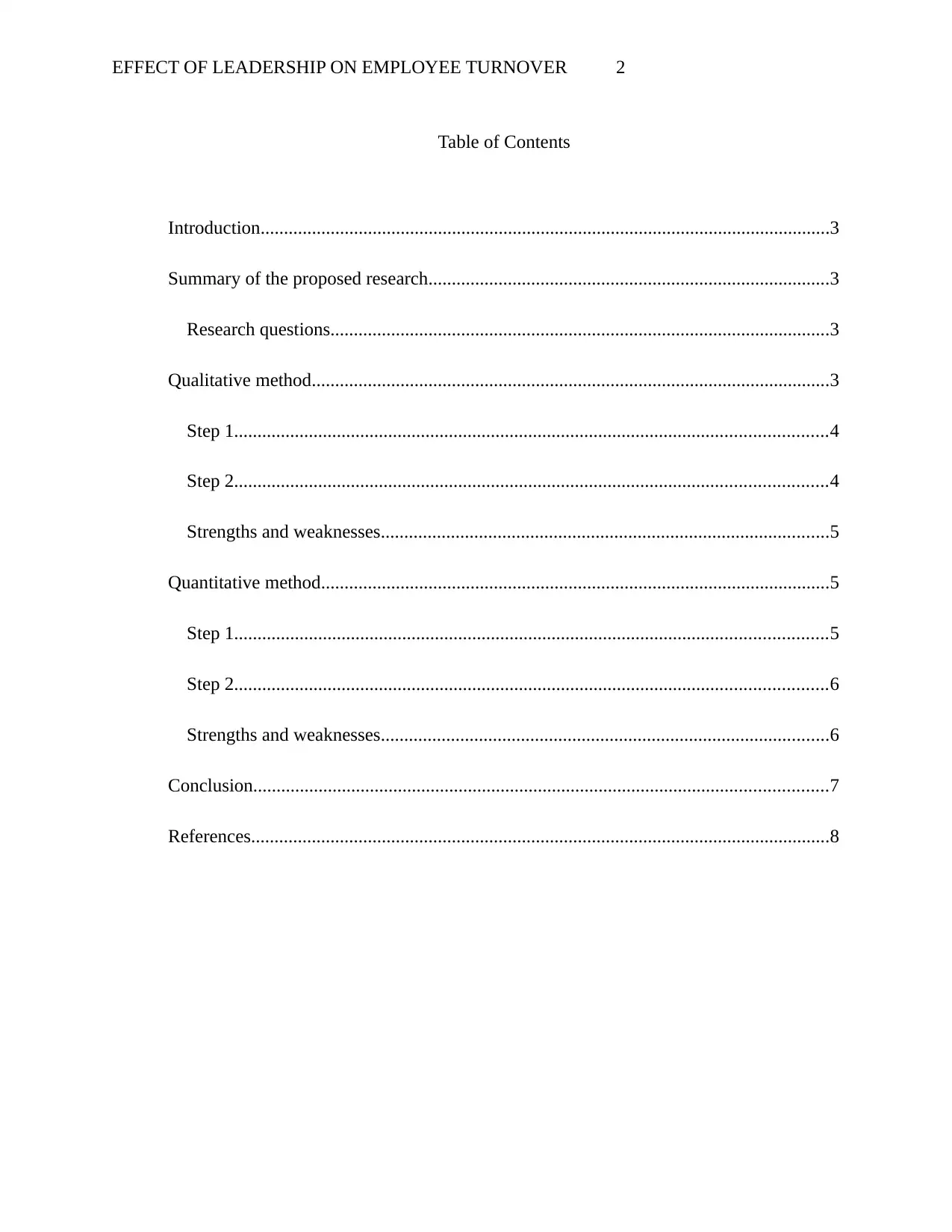
EFFECT OF LEADERSHIP ON EMPLOYEE TURNOVER 2
Table of Contents
Introduction..........................................................................................................................3
Summary of the proposed research......................................................................................3
Research questions...........................................................................................................3
Qualitative method...............................................................................................................3
Step 1...............................................................................................................................4
Step 2...............................................................................................................................4
Strengths and weaknesses................................................................................................5
Quantitative method.............................................................................................................5
Step 1...............................................................................................................................5
Step 2...............................................................................................................................6
Strengths and weaknesses................................................................................................6
Conclusion...........................................................................................................................7
References............................................................................................................................8
Table of Contents
Introduction..........................................................................................................................3
Summary of the proposed research......................................................................................3
Research questions...........................................................................................................3
Qualitative method...............................................................................................................3
Step 1...............................................................................................................................4
Step 2...............................................................................................................................4
Strengths and weaknesses................................................................................................5
Quantitative method.............................................................................................................5
Step 1...............................................................................................................................5
Step 2...............................................................................................................................6
Strengths and weaknesses................................................................................................6
Conclusion...........................................................................................................................7
References............................................................................................................................8
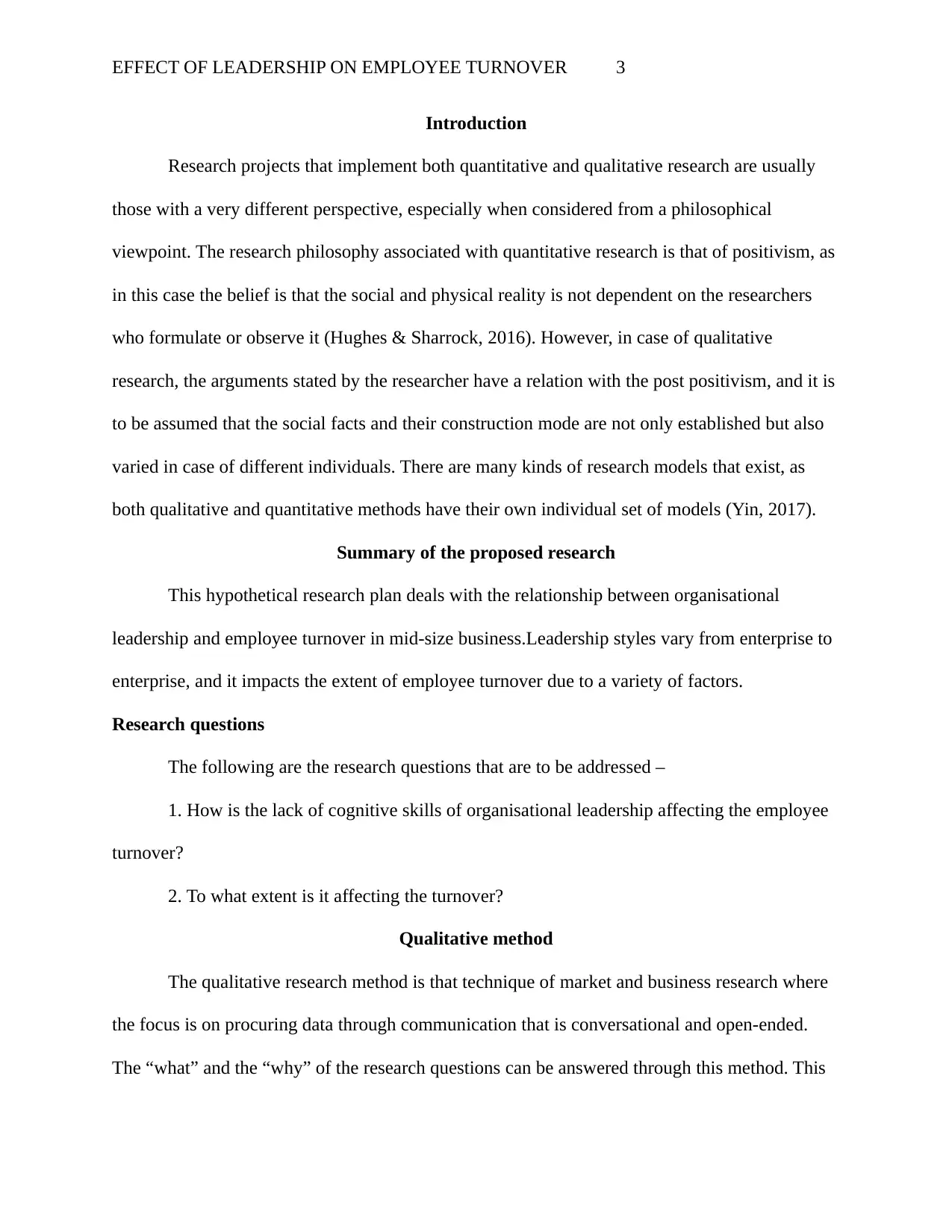
EFFECT OF LEADERSHIP ON EMPLOYEE TURNOVER 3
Introduction
Research projects that implement both quantitative and qualitative research are usually
those with a very different perspective, especially when considered from a philosophical
viewpoint. The research philosophy associated with quantitative research is that of positivism, as
in this case the belief is that the social and physical reality is not dependent on the researchers
who formulate or observe it (Hughes & Sharrock, 2016). However, in case of qualitative
research, the arguments stated by the researcher have a relation with the post positivism, and it is
to be assumed that the social facts and their construction mode are not only established but also
varied in case of different individuals. There are many kinds of research models that exist, as
both qualitative and quantitative methods have their own individual set of models (Yin, 2017).
Summary of the proposed research
This hypothetical research plan deals with the relationship between organisational
leadership and employee turnover in mid-size business.Leadership styles vary from enterprise to
enterprise, and it impacts the extent of employee turnover due to a variety of factors.
Research questions
The following are the research questions that are to be addressed –
1. How is the lack of cognitive skills of organisational leadership affecting the employee
turnover?
2. To what extent is it affecting the turnover?
Qualitative method
The qualitative research method is that technique of market and business research where
the focus is on procuring data through communication that is conversational and open-ended.
The “what” and the “why” of the research questions can be answered through this method. This
Introduction
Research projects that implement both quantitative and qualitative research are usually
those with a very different perspective, especially when considered from a philosophical
viewpoint. The research philosophy associated with quantitative research is that of positivism, as
in this case the belief is that the social and physical reality is not dependent on the researchers
who formulate or observe it (Hughes & Sharrock, 2016). However, in case of qualitative
research, the arguments stated by the researcher have a relation with the post positivism, and it is
to be assumed that the social facts and their construction mode are not only established but also
varied in case of different individuals. There are many kinds of research models that exist, as
both qualitative and quantitative methods have their own individual set of models (Yin, 2017).
Summary of the proposed research
This hypothetical research plan deals with the relationship between organisational
leadership and employee turnover in mid-size business.Leadership styles vary from enterprise to
enterprise, and it impacts the extent of employee turnover due to a variety of factors.
Research questions
The following are the research questions that are to be addressed –
1. How is the lack of cognitive skills of organisational leadership affecting the employee
turnover?
2. To what extent is it affecting the turnover?
Qualitative method
The qualitative research method is that technique of market and business research where
the focus is on procuring data through communication that is conversational and open-ended.
The “what” and the “why” of the research questions can be answered through this method. This
⊘ This is a preview!⊘
Do you want full access?
Subscribe today to unlock all pages.

Trusted by 1+ million students worldwide
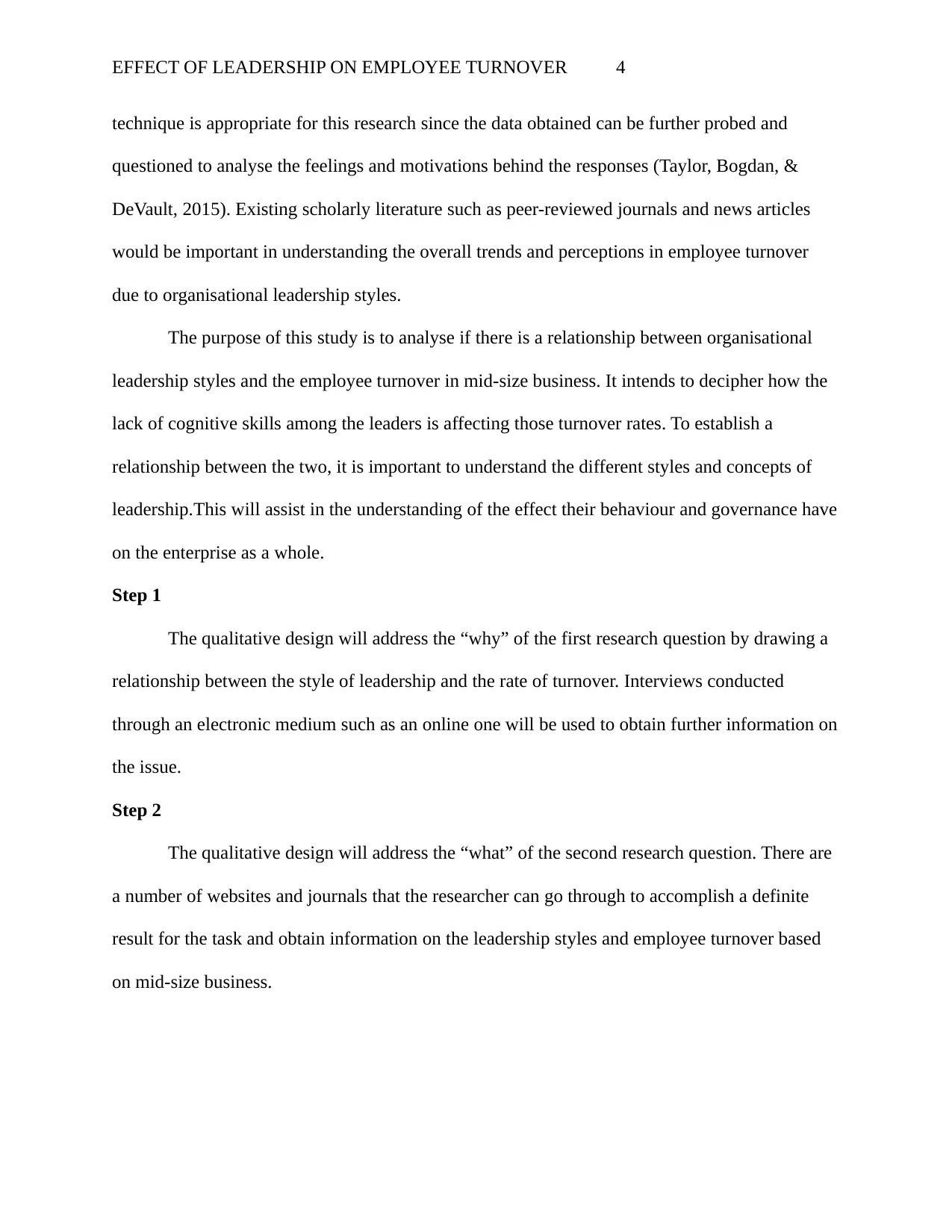
EFFECT OF LEADERSHIP ON EMPLOYEE TURNOVER 4
technique is appropriate for this research since the data obtained can be further probed and
questioned to analyse the feelings and motivations behind the responses (Taylor, Bogdan, &
DeVault, 2015). Existing scholarly literature such as peer-reviewed journals and news articles
would be important in understanding the overall trends and perceptions in employee turnover
due to organisational leadership styles.
The purpose of this study is to analyse if there is a relationship between organisational
leadership styles and the employee turnover in mid-size business. It intends to decipher how the
lack of cognitive skills among the leaders is affecting those turnover rates. To establish a
relationship between the two, it is important to understand the different styles and concepts of
leadership.This will assist in the understanding of the effect their behaviour and governance have
on the enterprise as a whole.
Step 1
The qualitative design will address the “why” of the first research question by drawing a
relationship between the style of leadership and the rate of turnover. Interviews conducted
through an electronic medium such as an online one will be used to obtain further information on
the issue.
Step 2
The qualitative design will address the “what” of the second research question. There are
a number of websites and journals that the researcher can go through to accomplish a definite
result for the task and obtain information on the leadership styles and employee turnover based
on mid-size business.
technique is appropriate for this research since the data obtained can be further probed and
questioned to analyse the feelings and motivations behind the responses (Taylor, Bogdan, &
DeVault, 2015). Existing scholarly literature such as peer-reviewed journals and news articles
would be important in understanding the overall trends and perceptions in employee turnover
due to organisational leadership styles.
The purpose of this study is to analyse if there is a relationship between organisational
leadership styles and the employee turnover in mid-size business. It intends to decipher how the
lack of cognitive skills among the leaders is affecting those turnover rates. To establish a
relationship between the two, it is important to understand the different styles and concepts of
leadership.This will assist in the understanding of the effect their behaviour and governance have
on the enterprise as a whole.
Step 1
The qualitative design will address the “why” of the first research question by drawing a
relationship between the style of leadership and the rate of turnover. Interviews conducted
through an electronic medium such as an online one will be used to obtain further information on
the issue.
Step 2
The qualitative design will address the “what” of the second research question. There are
a number of websites and journals that the researcher can go through to accomplish a definite
result for the task and obtain information on the leadership styles and employee turnover based
on mid-size business.
Paraphrase This Document
Need a fresh take? Get an instant paraphrase of this document with our AI Paraphraser
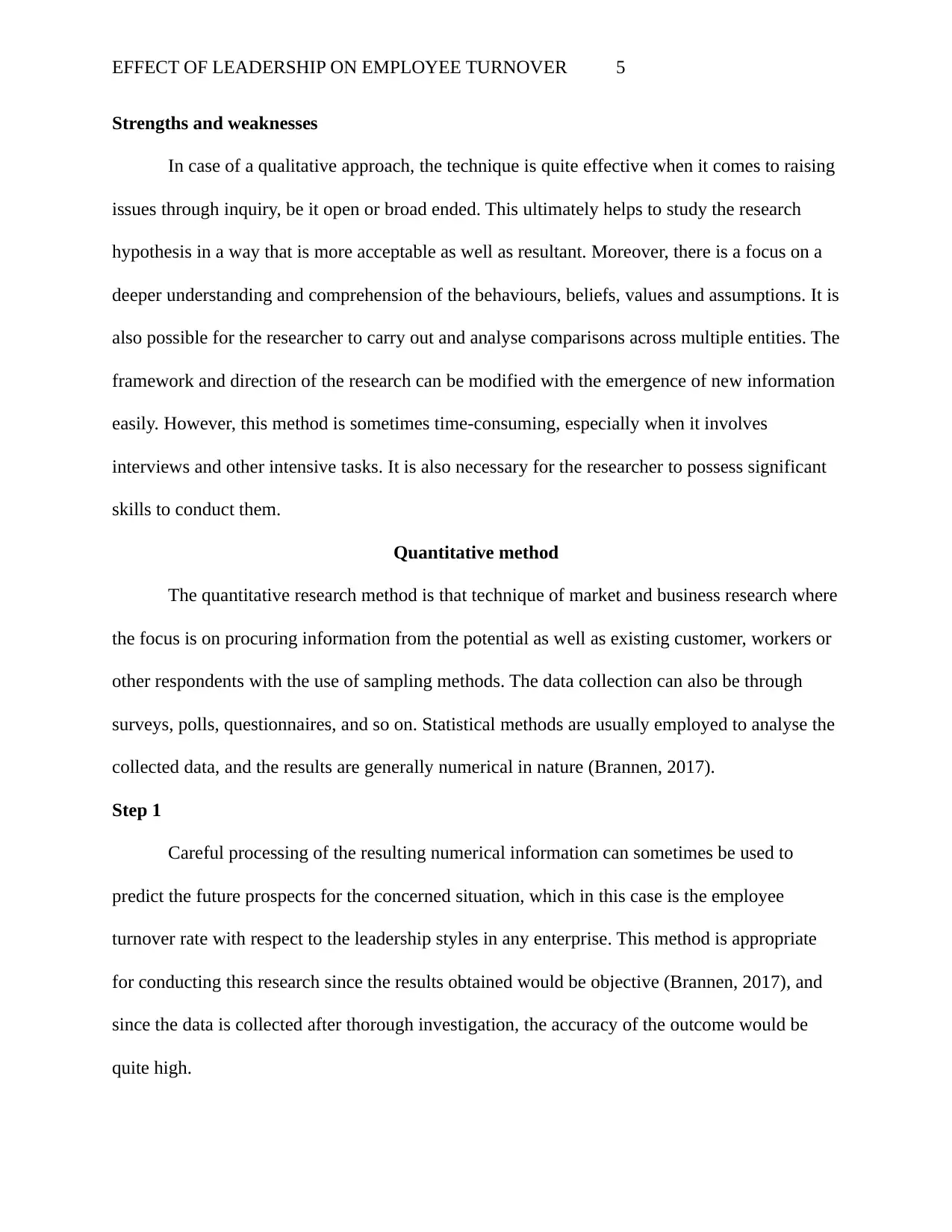
EFFECT OF LEADERSHIP ON EMPLOYEE TURNOVER 5
Strengths and weaknesses
In case of a qualitative approach, the technique is quite effective when it comes to raising
issues through inquiry, be it open or broad ended. This ultimately helps to study the research
hypothesis in a way that is more acceptable as well as resultant. Moreover, there is a focus on a
deeper understanding and comprehension of the behaviours, beliefs, values and assumptions. It is
also possible for the researcher to carry out and analyse comparisons across multiple entities. The
framework and direction of the research can be modified with the emergence of new information
easily. However, this method is sometimes time-consuming, especially when it involves
interviews and other intensive tasks. It is also necessary for the researcher to possess significant
skills to conduct them.
Quantitative method
The quantitative research method is that technique of market and business research where
the focus is on procuring information from the potential as well as existing customer, workers or
other respondents with the use of sampling methods. The data collection can also be through
surveys, polls, questionnaires, and so on. Statistical methods are usually employed to analyse the
collected data, and the results are generally numerical in nature (Brannen, 2017).
Step 1
Careful processing of the resulting numerical information can sometimes be used to
predict the future prospects for the concerned situation, which in this case is the employee
turnover rate with respect to the leadership styles in any enterprise. This method is appropriate
for conducting this research since the results obtained would be objective (Brannen, 2017), and
since the data is collected after thorough investigation, the accuracy of the outcome would be
quite high.
Strengths and weaknesses
In case of a qualitative approach, the technique is quite effective when it comes to raising
issues through inquiry, be it open or broad ended. This ultimately helps to study the research
hypothesis in a way that is more acceptable as well as resultant. Moreover, there is a focus on a
deeper understanding and comprehension of the behaviours, beliefs, values and assumptions. It is
also possible for the researcher to carry out and analyse comparisons across multiple entities. The
framework and direction of the research can be modified with the emergence of new information
easily. However, this method is sometimes time-consuming, especially when it involves
interviews and other intensive tasks. It is also necessary for the researcher to possess significant
skills to conduct them.
Quantitative method
The quantitative research method is that technique of market and business research where
the focus is on procuring information from the potential as well as existing customer, workers or
other respondents with the use of sampling methods. The data collection can also be through
surveys, polls, questionnaires, and so on. Statistical methods are usually employed to analyse the
collected data, and the results are generally numerical in nature (Brannen, 2017).
Step 1
Careful processing of the resulting numerical information can sometimes be used to
predict the future prospects for the concerned situation, which in this case is the employee
turnover rate with respect to the leadership styles in any enterprise. This method is appropriate
for conducting this research since the results obtained would be objective (Brannen, 2017), and
since the data is collected after thorough investigation, the accuracy of the outcome would be
quite high.
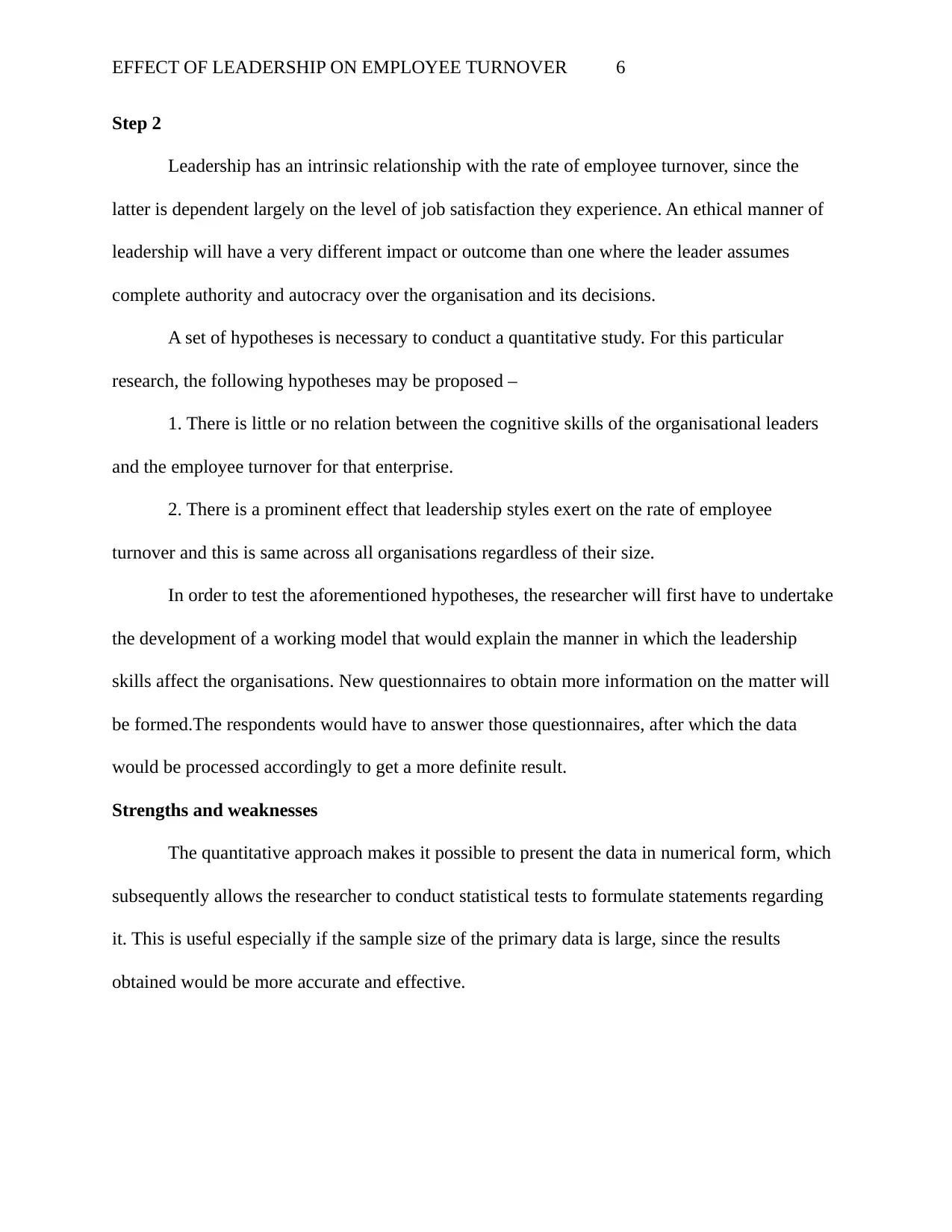
EFFECT OF LEADERSHIP ON EMPLOYEE TURNOVER 6
Step 2
Leadership has an intrinsic relationship with the rate of employee turnover, since the
latter is dependent largely on the level of job satisfaction they experience. An ethical manner of
leadership will have a very different impact or outcome than one where the leader assumes
complete authority and autocracy over the organisation and its decisions.
A set of hypotheses is necessary to conduct a quantitative study. For this particular
research, the following hypotheses may be proposed –
1. There is little or no relation between the cognitive skills of the organisational leaders
and the employee turnover for that enterprise.
2. There is a prominent effect that leadership styles exert on the rate of employee
turnover and this is same across all organisations regardless of their size.
In order to test the aforementioned hypotheses, the researcher will first have to undertake
the development of a working model that would explain the manner in which the leadership
skills affect the organisations. New questionnaires to obtain more information on the matter will
be formed.The respondents would have to answer those questionnaires, after which the data
would be processed accordingly to get a more definite result.
Strengths and weaknesses
The quantitative approach makes it possible to present the data in numerical form, which
subsequently allows the researcher to conduct statistical tests to formulate statements regarding
it. This is useful especially if the sample size of the primary data is large, since the results
obtained would be more accurate and effective.
Step 2
Leadership has an intrinsic relationship with the rate of employee turnover, since the
latter is dependent largely on the level of job satisfaction they experience. An ethical manner of
leadership will have a very different impact or outcome than one where the leader assumes
complete authority and autocracy over the organisation and its decisions.
A set of hypotheses is necessary to conduct a quantitative study. For this particular
research, the following hypotheses may be proposed –
1. There is little or no relation between the cognitive skills of the organisational leaders
and the employee turnover for that enterprise.
2. There is a prominent effect that leadership styles exert on the rate of employee
turnover and this is same across all organisations regardless of their size.
In order to test the aforementioned hypotheses, the researcher will first have to undertake
the development of a working model that would explain the manner in which the leadership
skills affect the organisations. New questionnaires to obtain more information on the matter will
be formed.The respondents would have to answer those questionnaires, after which the data
would be processed accordingly to get a more definite result.
Strengths and weaknesses
The quantitative approach makes it possible to present the data in numerical form, which
subsequently allows the researcher to conduct statistical tests to formulate statements regarding
it. This is useful especially if the sample size of the primary data is large, since the results
obtained would be more accurate and effective.
⊘ This is a preview!⊘
Do you want full access?
Subscribe today to unlock all pages.

Trusted by 1+ million students worldwide
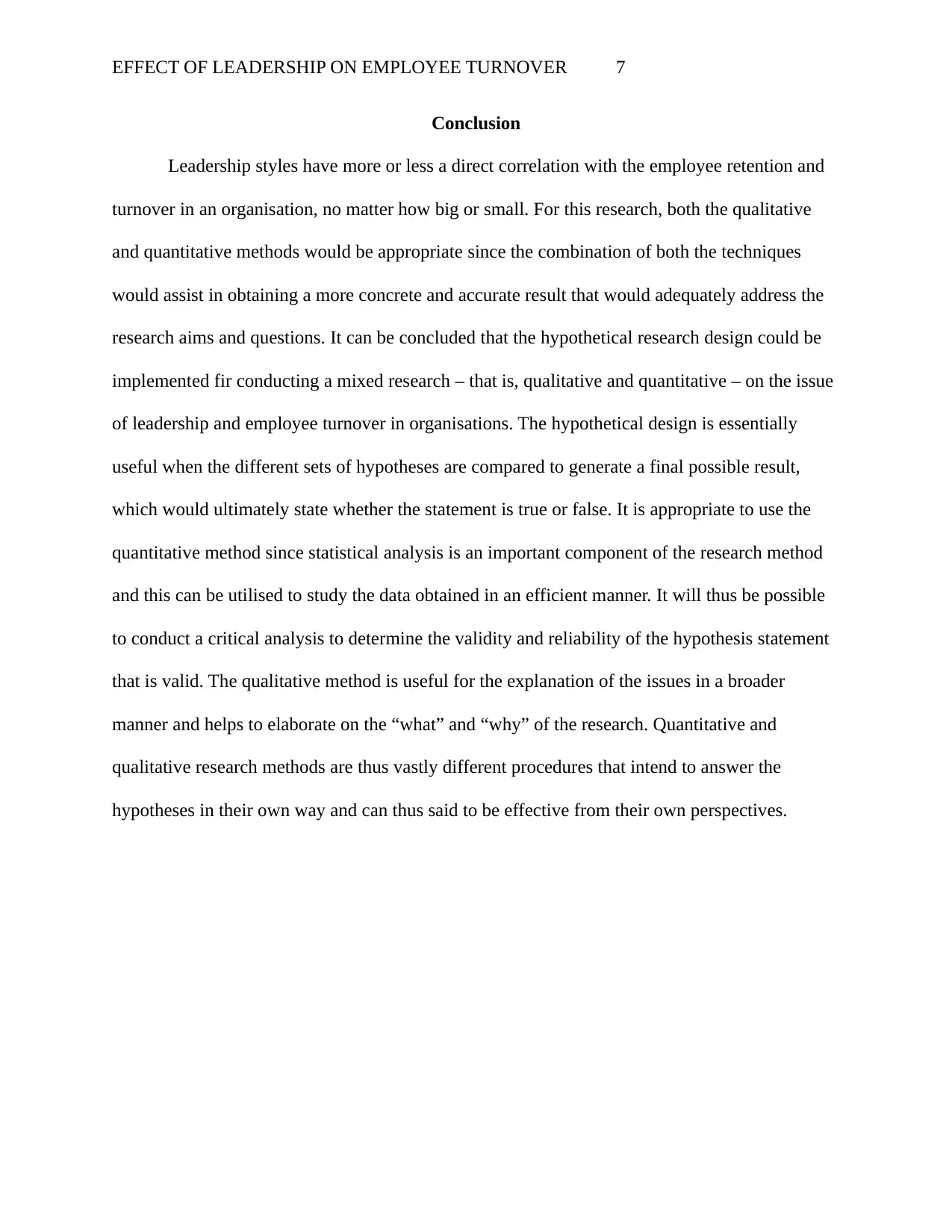
EFFECT OF LEADERSHIP ON EMPLOYEE TURNOVER 7
Conclusion
Leadership styles have more or less a direct correlation with the employee retention and
turnover in an organisation, no matter how big or small. For this research, both the qualitative
and quantitative methods would be appropriate since the combination of both the techniques
would assist in obtaining a more concrete and accurate result that would adequately address the
research aims and questions. It can be concluded that the hypothetical research design could be
implemented fir conducting a mixed research – that is, qualitative and quantitative – on the issue
of leadership and employee turnover in organisations. The hypothetical design is essentially
useful when the different sets of hypotheses are compared to generate a final possible result,
which would ultimately state whether the statement is true or false. It is appropriate to use the
quantitative method since statistical analysis is an important component of the research method
and this can be utilised to study the data obtained in an efficient manner. It will thus be possible
to conduct a critical analysis to determine the validity and reliability of the hypothesis statement
that is valid. The qualitative method is useful for the explanation of the issues in a broader
manner and helps to elaborate on the “what” and “why” of the research. Quantitative and
qualitative research methods are thus vastly different procedures that intend to answer the
hypotheses in their own way and can thus said to be effective from their own perspectives.
Conclusion
Leadership styles have more or less a direct correlation with the employee retention and
turnover in an organisation, no matter how big or small. For this research, both the qualitative
and quantitative methods would be appropriate since the combination of both the techniques
would assist in obtaining a more concrete and accurate result that would adequately address the
research aims and questions. It can be concluded that the hypothetical research design could be
implemented fir conducting a mixed research – that is, qualitative and quantitative – on the issue
of leadership and employee turnover in organisations. The hypothetical design is essentially
useful when the different sets of hypotheses are compared to generate a final possible result,
which would ultimately state whether the statement is true or false. It is appropriate to use the
quantitative method since statistical analysis is an important component of the research method
and this can be utilised to study the data obtained in an efficient manner. It will thus be possible
to conduct a critical analysis to determine the validity and reliability of the hypothesis statement
that is valid. The qualitative method is useful for the explanation of the issues in a broader
manner and helps to elaborate on the “what” and “why” of the research. Quantitative and
qualitative research methods are thus vastly different procedures that intend to answer the
hypotheses in their own way and can thus said to be effective from their own perspectives.
Paraphrase This Document
Need a fresh take? Get an instant paraphrase of this document with our AI Paraphraser
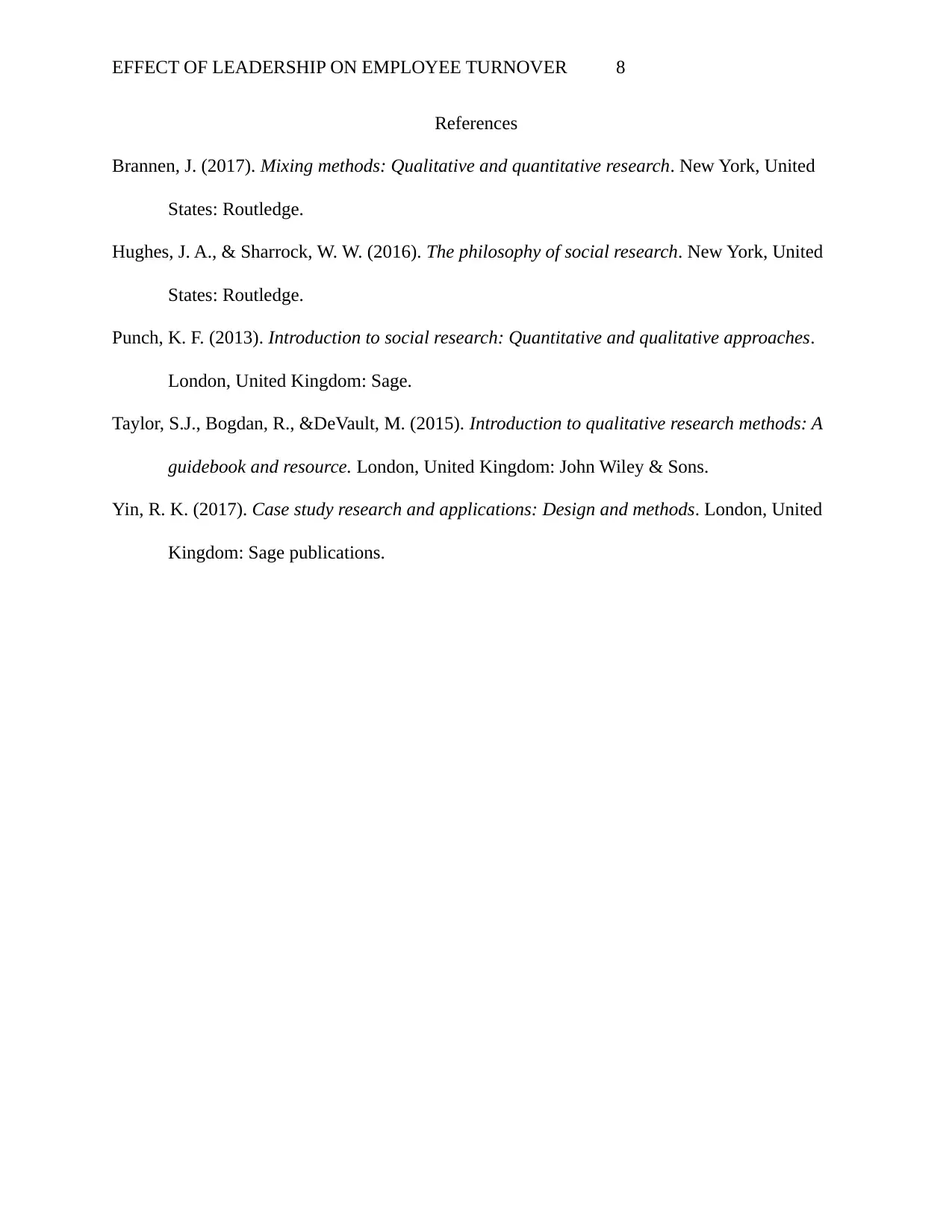
EFFECT OF LEADERSHIP ON EMPLOYEE TURNOVER 8
References
Brannen, J. (2017). Mixing methods: Qualitative and quantitative research. New York, United
States: Routledge.
Hughes, J. A., & Sharrock, W. W. (2016). The philosophy of social research. New York, United
States: Routledge.
Punch, K. F. (2013). Introduction to social research: Quantitative and qualitative approaches.
London, United Kingdom: Sage.
Taylor, S.J., Bogdan, R., &DeVault, M. (2015). Introduction to qualitative research methods: A
guidebook and resource. London, United Kingdom: John Wiley & Sons.
Yin, R. K. (2017). Case study research and applications: Design and methods. London, United
Kingdom: Sage publications.
References
Brannen, J. (2017). Mixing methods: Qualitative and quantitative research. New York, United
States: Routledge.
Hughes, J. A., & Sharrock, W. W. (2016). The philosophy of social research. New York, United
States: Routledge.
Punch, K. F. (2013). Introduction to social research: Quantitative and qualitative approaches.
London, United Kingdom: Sage.
Taylor, S.J., Bogdan, R., &DeVault, M. (2015). Introduction to qualitative research methods: A
guidebook and resource. London, United Kingdom: John Wiley & Sons.
Yin, R. K. (2017). Case study research and applications: Design and methods. London, United
Kingdom: Sage publications.
1 out of 8
Related Documents
Your All-in-One AI-Powered Toolkit for Academic Success.
+13062052269
info@desklib.com
Available 24*7 on WhatsApp / Email
![[object Object]](/_next/static/media/star-bottom.7253800d.svg)
Unlock your academic potential
Copyright © 2020–2025 A2Z Services. All Rights Reserved. Developed and managed by ZUCOL.





